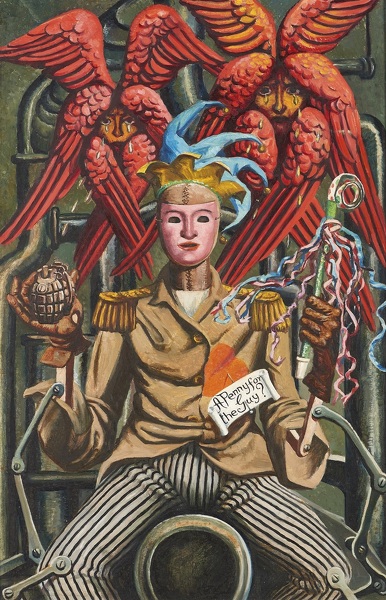Provenance: Michael Parkin Gallery; Tadema Gallery; Private collection
Exhibited: 50/50; Fifty British Women Artists 1900 – 1950, Worshipful Company of Mercers (3rd December 2018 - 23rd March, 2019); The Stanley & Audrey Burton Gallery, University of Leeds (9th April, 2019 - 27th July, 2019).'For Real: British Realists from the 20s and 30s', Museum MORE, Gorssel (September 15th, 2019 – January 5th, 2020).
The presence of my great aunt Gladys Hynes has ebbed and flowed through my life in various ways, few more cogently than the dietrologia – as the Italians say, the schema of what lies behind things – of this painting. Which, since I have been a war reporter, is unsurprising: it depicts a profiteer from warfare; the iniquitous city gent, a fearsome nonentity, in pin stripes with mechanical arm, grenade and bulging codpiece – his masculinity made base.
In addition to the depicted title, an inscription (possibly by Aunt Gladys) on the back reads:
“Penny for the Guy – the thought that all war is caused by
the faceless money men of the City.”
The same figure recurs in one of Hynes’ meticulous but appositely mystical line illustrations to the Cantos nos. XVII to XXVII by her friend Ezra Pound – that to ‘Canto XIX’.[112]
Aesthetically, Gladys defies utterly that dictum whereby artists are, as Delacroix put it, “fossilized into schools”. She is singular in every way, as she was in her life. Gladys and her sisters – older Eileen, my grandmother, and younger Sheelah – were Irish republicans, suffragettes and socialists, and also pacifist in a way that seemed to apply to everywhere apart from Ireland (they supported the revolution and opposed the treaty) and republican Spain. And there is searing pacifism in this picture, though not of the kind the war artists had brought home in 1918.
Painting in Britain and Germany was famously haunted by World War One and its aftermath, but Gladys here addresses the ‘just war’: its sequel, as early as 1940, when Europe – apparently doomed – was yet to learn the worst about the Third Reich.Her subject is not war or the pity of war, but those of whom Bob Dylan wrote in his great Masters of War: “Ye that build the big guns”. Gladys’ ‘Master of War’ wears a pallid mask, evocative of James Ensor, to give him oblique indifference; “Ye that hide behind walls / Ye that hide behind desks”, wrote Dylan. He is bane and demoniac, while Gladys was a devout Catholic.What this man does makes even the Angels weep; for Dylan, “even Jesus would never forgive what you do”.
In this way, Gladys’ painting is of, yet transcends, its time. Looking at the painting now, she depicts those who grew rich from every shell that fell on the Sarajevo I reported, under siege; the lucrative, sordid malevolence of fortunes made by those who ravaged Iraq while I worked there; those squalid billions laundered with impunity; proceeds from the carnage of drugs wars I write about, from Mexico and Colombia, snorted up Europe’s and America’s noses for kicks; every line of blood. It could be the money made from British weapons sold to Saudi Arabia that rain down on children in Yemen, or the American military-industrial-complex that crushed Latin America for most of my lifetime. Gladys paints this. She was an effervescent woman but also passionate, and wore her righteous rage as well as her poetic imagination in paint.
Post Scriptum: In June 2018, I arranged to meet the curator of this exhibition and catalogue for lunch, to discuss this painting. By the end of the same day, by pure serendipity and through an entirely different route, she had become its owner. So that this picture at least returns, as it were, to the family.
Commentary by Ed Vulliamy. Vulliamy has been a writer for the Guardian and Observer newspapers for over thirty years. He has won every major prize in British journalism for his reporting from Bosnia, Italy, Iraq and Mexico. He is the author of America: War Along the Borderline (2010, the Ryszard Kapuscinski Award), The War is Dead, Long Live the War, Bosnia: The Reckoning (2012) and When Words Fail: A Life with Music, War And Peace (2018).
IN 1940 10 May: Winston Churchill becames prime minister of the coalition government; The Butler Act created free secondary education to the age of 15.
The series of 'Careless Talk Costs Lives' propaganda posters by 'Fougasse' was published by the Ministry of Information
The War Artists' Advisory Committee of the U.K. Ministry of Information opens its first exhibition of War Pictures by British Artists to the public at the otherwise-evacuated National Gallery in London.
Walt Disney's animated movie Fantasia realeased.
Mexican painters Frida Kahlo and Diego Rivera remarried in San Francisco.
Cecil Beaton is among the photographers commissioned by the U.K. Ministry of Information to undertake war photography.
Henry Moore is commissioned as a war artist and produces drawings of Londoners sleeping in the London Underground while sheltering from The Blitz.
Anthony Blunt's Artistic Theory in Italy 1450–1600 is published. This year he is recruited to work for MI5 while simultaneously spying for the NKVD.
ARTWORKS CREATED IN 1940:
Vanessa Bell – Leonard Woolf
Clive Branson – Noreen and Rosa
Charles Cundall – The Withdrawal from Dunkirk, June 1940
Salvador Dalí - Slave Market with the Disap
Edward Hopper Gas
Frida Kahlo - The Dream
Conroy Maddox – The Strange Country
Henri Matisse - Le Rêve de 1940
Roberto Matta – Dark Light
John Piper - Coventry Cathedral
Eric Ravilious – A Warship in Dock
Graham Sutherland - Black Landscape
Édouard Vuillard, (b. 1868), Paul Klee, (b. 1879), Colin Gill, (b. 1892) and Eric Gill, English(b. 1882) died in 1940















